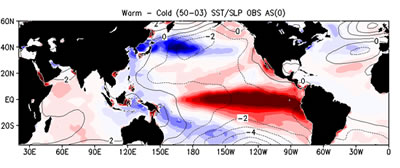The Influence of Local and Remote Processes on Air-Sea Interaction over Western Boundary Current Regions
by Michael Alexander
Mike is interested in the atmospheric and oceanic processes that lead to SST variability in WBC regions and how the SST anomalies feedback on the atmosphere. Local processes that impact SST variability in the Kuroshio and Gulf Stream regions include surface fluxes and the “reemergence mechanism” (e.g. Alexander and Deser 1995). In the latter, temperature anomalies created by surface fluxes are spread by turbulence over the deep winter mixed layer. After the mixed layer abruptly shoals in spring, the anomalies are stored in the seasonal thermocline during summer, when surface fluxes damp the concurrent SST anomalies. The thermal anomalies are then re-entrained into the mixed layer when it again deepens in the following fall and winter. The reemergence process enhances the winter-to-winter persistence of SST anomalies (Deser et al. 2002; Park et al. 2006) and can impact the atmospheric circulation when the thermal anomalies return to the surface in the following winter (Cassou et al. 2007 and Liu et al. 2007).
Variability in the Kuroshio and Gulf Stream regions are influenced by remote air-sea interactions in other parts of the extratropics. Fluctuations in wind stress curl over the central North Pacific and North Atlantic generate oceanic Rossby waves that impact thermocline depth and the strength of the WBCs 3-7 years later. The resulting changes in the strength and position of the WBCs affect the SSTs, alter the surface heat fluxes, and thereby feedback on the atmospheric circulation. This coupled atmosphere-ocean interaction appears to generate decadal oscillations over the North Pacific in the NCAR coupled climate model (Alexander et al. 2006, Kwon and Deser 2007).

Air-sea interaction in the western North Pacific and North Atlantic are also influenced by atmospheric signals originating in the tropics. ENSO and lower-frequency changes in the Indo-Pacific basin, alter the wind stress, surface fluxes and precipitation over the North Pacific, which can then impact the underlying ocean. The ENSO-induced changes are not limited to winter, as SST anomalies in the Kuroshio region are larger than their winter counterparts (See Fig. 1 and Alexander et al. 2004). Similarly, changes in the tropical Atlantic influence the North Atlantic over the course of the seasonal cycle (Peng et al. 2005, 2006).
